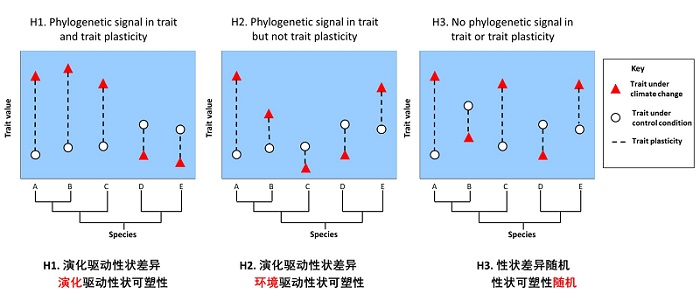

Plant plastic responses are critical to the adaptation and survival of species under climate change, but whether they are constrained by evolutionary history (phylogeny) is largely unclear. Plant leaf traits are key in determining plants’ performance in different environments, and if these traits and their plasticity are phylogenetically dependent, predictions could be made to identify species vulnerable to climate change.
To explore answers for the question “Can evolutionary history predict plant plastic responses to climate change?”, researchers from South China Botanical Garden, Chinese Academy of Sciences, compiled data on three leaf traits (photosynthetic rate, specific leaf area, and leaf nitrogen content) of 434 species and their plasticity under four climate change scenarios (warming, drought, elevated CO2, or nitrogen addition) from 210 manipulation experiments. They found phylogenetic signals in the three traits but not in their plasticity under the four scenarios (Figure 1 H2). This indicates that closely related species show similar traits but that their plastic responses could not be predicted from species relatedness under environmental change. Meanwhile, phylogeny weakened but did not change directions of conventional pairwise trait relationships, suggesting the co-evolved leaf trait pairs have consistent responses across contrasting environmental conditions. Overall, phylogeny can identify lineages rich in species showing similar traits and predict their relationships under climate change, but the degree of plant trait plasticity does not vary consistently across evolutionary clades.
This study expanded the knowledge of adaptation and coordination of leaf economic traits under climate change from an evolutionary perspective. Relevant results have been published online in New Phytologist: https://doi.org/10.1111/nph.18194

Figure 1 A schematic diagram and hypotheses demonstrating the presence or absence of phylogenetic signal in a hypothetical plant trait under climate change and its plasticity. In hypothesis 1 (evolution-driven trait response), evolutionary history influences the trait of species A-E under control conditions (white circles), and under climate change (red triangles), as well as the ability to change the trait under different conditions (trait plasticity; the dashed line). Therefore, closely-related species show more similar trait values and trait plasticity than those more distantly-related (i.e., there is phylogenetic signal in the trait and its plasticity). In hypothesis 2 (environment-driven trait response), phylogenetic signal exists in trait values but not in trait plasticity. In hypothesis 3 (random trait response), there is no phylogenetic signal in either the trait or trait plasticity. The phylogeny below each panel shows the evolutionary relationships between the five hypothetical species, with species A most closely related to B, then C, and most distantly-related to D and E.

